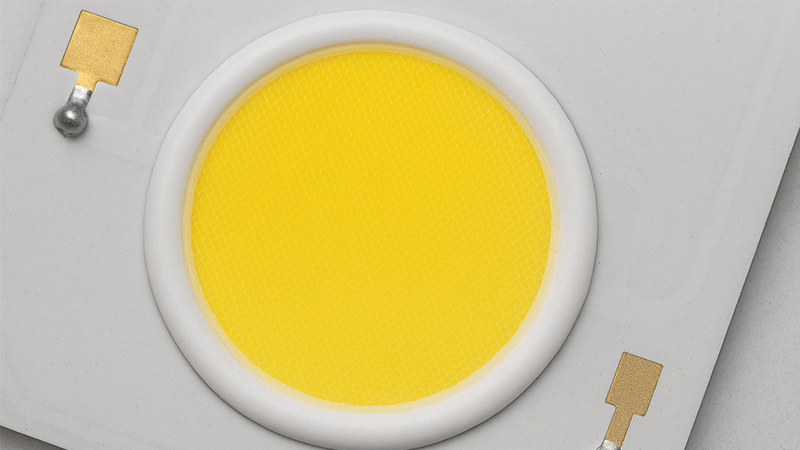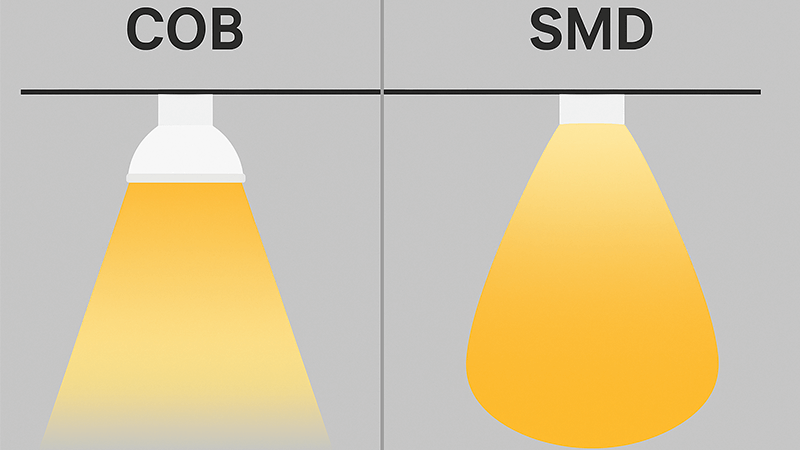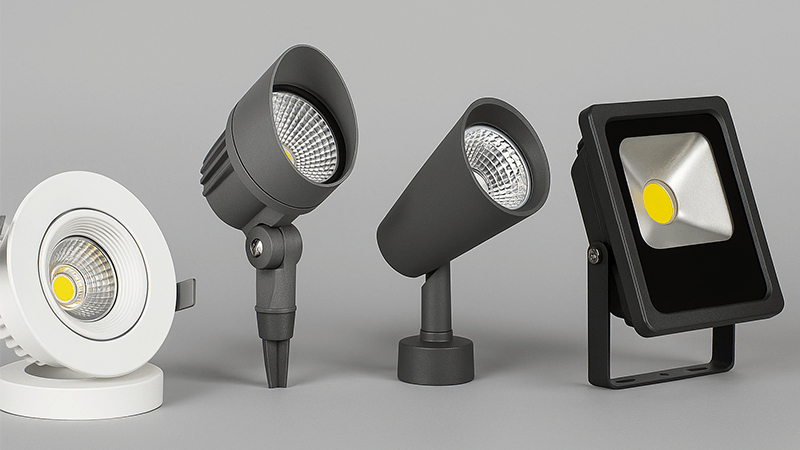Are you confused by lighting terms? Choosing the wrong fixture can affect your project’s entire look and feel. Let’s make the right choice together.
A downlight is a type of light fixture, while COB (Chip-on-Board) is a type of LED light source inside it. The main difference is the technology. A COB downlight uses a single, powerful light source for a focused beam, while a standard SMD downlight uses multiple smaller LEDs for broader light.

That sounds simple, but the choice between these technologies is one of the most important decisions in a lighting project. The type of LED chip inside the fixture completely changes the quality, feel, and function of the light. To really understand which one is best for your needs, we need to dive deeper into how they work and what they do best.
What is a COB downlight?
Heard the term "COB downlight" used by suppliers? Not knowing the specifics can make it hard to source the right product. I’ll explain what makes it special.
A COB downlight is a recessed fixture using a "Chip-on-Board" light source. This technology packs many tiny LED diodes onto a single chip, making them act as one powerful point of light. This creates a clean, focused beam similar to a traditional halogen lamp but much more efficient.

To really get it, you need to understand the technology behind the name. When I first started in this industry, we mainly worked with SMD, or "Surface Mounted Device," LEDs. These are individual chips soldered onto a circuit board. A standard downlight might have a dozen or more of these small SMD chips. They are great for creating a wide, general light, like lighting up a whole room evenly.
Then came COB technology. I remember the first time I saw a COB chip up close in our factory. It was a game-changer. Instead of many separate light points, COB technology places a high density of LED diodes directly onto a substrate, usually made of ceramic or aluminum. These diodes are then covered with a layer of phosphor. The result is a single, uniform, and very intense light-emitting surface.
This single-point design is the key.
Why a Single Light Source Matters
With SMD downlights, the multiple light points can sometimes create multiple shadows, which can be distracting and make a space feel less clean. A COB downlight emits light from one point, just like a classic halogen bulb. This gives you a single, crisp shadow and a very clean, high-quality light beam. It’s perfect for creating drama and highlighting specific features.
Superior Light Control
Because the light comes from one small, defined area, it is much easier to control with optics like reflectors and lenses. We can shape the beam very precisely, from a narrow spotlight to a wider floodlight, without much light spill or glare. For a project manager like Shaz, who needs specific lighting effects for retail or hospitality projects, this level of control is essential. This is why you see COB downlights used so often in high-end hotels, art galleries, and luxury stores where the quality of light is paramount.
| Feature |
COB (Chip-on-Board) |
SMD (Surface Mounted Device) |
| Light Source |
Single, unified point of light |
Multiple, separate points of light |
| Beam Quality |
Focused, clean beam; single shadow |
Wide, diffused beam; potential for multiple shadows |
| Optical Control |
Excellent; easy to shape with lenses/reflectors |
Good; harder to achieve narrow, focused beams |
| Best For |
Accent lighting, high ceilings, high-end applications |
General ambient lighting, wide area coverage |
When you’re sourcing lights, asking about the chip type is crucial. If a client wants to make their products look amazing or create a luxurious atmosphere, a COB downlight is almost always the right answer.
What are the disadvantages of COB lights?
Thinking COB is the perfect solution for everything? Overlooking its drawbacks can lead to high costs and technical problems. Let’s look at the other side of the story.
The main disadvantages of COB lights are their concentrated heat generation, which requires a large, high-quality heat sink. Also, if a single diode on the chip fails, the entire COB module must be replaced. They can also have a higher upfront cost compared to standard SMD fixtures.

As a manufacturer, I can tell you that nothing is perfect. While COB technology produces beautiful light, it comes with its own set of engineering challenges. These are important for any purchasing manager to understand because they directly impact product quality, lifespan, and cost.
The Heat Problem
The biggest challenge with COB is heat management. Because so many diodes are packed into a tiny area, they generate a lot of heat in one concentrated spot. If that heat isn’t drawn away effectively, the chip’s temperature will rise, which can cause two major problems: the light output will decrease, and its lifespan will be drastically shortened. This is why a good COB downlight must have a substantial, well-designed heat sink.
I’ve seen many factories try to cut costs by using smaller, cheaper aluminum heat sinks. These products might look fine and work well for a few months, but they will fail prematurely. At my company, iPHD, we spend a lot of time on thermal engineering, ensuring our heat sinks are properly sized and made from high-grade aluminum to guarantee a long life for our lights. When you’re sourcing COB products, always inspect the heat sink. If it feels flimsy or too small for the wattage, it’s a red flag.
Maintenance and Repair
The second issue is repairability. A COB chip is a single, integrated unit. Unlike an SMD fixture where you could theoretically replace a single failed LED, that’s impossible with a COB. If even a small part of the chip fails, the entire module needs to be replaced. This makes field repairs more difficult and costly. For large-scale projects, this means it’s important to work with a reliable supplier who can provide replacement modules if needed.
Cost Considerations
Finally, there’s the cost. High-quality COB chips, especially those with a high CRI (Color Rendering Index), and the large heat sinks required, make COB downlights more expensive upfront than their SMD counterparts. For projects with a tight budget focused purely on general illumination, an SMD downlight might be a more practical choice. The extra cost of COB is for the superior light quality and control it provides.
So, while COB lights are excellent, they are not a one-size-fits-all solution. You have to weigh their benefits against these practical disadvantages.
Which is better, LED or COB light?
Struggling to decide between different LED types? This question often causes confusion, but the answer is simple. Let’s clear it up so you can compare products accurately.
This question is based on a misunderstanding. COB (Chip-on-Board) is a type of LED. The real question is: "Which is better, COB LED or SMD LED?" The answer depends on your application. COB is better for focused, high-quality accent lighting, while SMD is better for wide, general illumination.

I hear this question a lot, and it’s important to get the terminology right. "LED" (Light Emitting Diode) is the general name for the technology. Both COB and SMD are just different ways of packaging and arranging those LEDs. Think of it like cars: asking if you prefer a "car" or a "sedan" doesn’t make sense because a sedan is a type of car.
The right way to approach this is to compare the two dominant packaging types for downlights: COB and SMD. I’ve helped countless clients, from Dubai to Europe, make this choice. The decision always comes down to the lighting goal.
When to Choose COB
You should choose a COB downlight when the quality of light is more important than the quantity of light. Its single-point source creates a focused, high-contrast beam that is perfect for:
- Accent Lighting: Making artwork, products, or architectural details stand out.
- High Ceilings: The powerful, directional beam can punch light down from high ceilings without losing intensity.
- Creating Ambiance: The clean, crisp light feels more luxurious and is often used in high-end residential, hospitality, and retail spaces.
- Avoiding Glare: A well-designed COB downlight with a good reflector will have a deep regression, hiding the light source from view and creating a more comfortable experience.
When to Choose SMD
You should choose an SMD downlight when you need efficient, widespread, and cost-effective general lighting. The multiple light sources spread the light over a wider area, making them ideal for:
- General Illumination: Lighting up an entire office, hallway, or kitchen evenly.
- Low Ceilings: The wide beam angle covers more area from a lower height.
- Budget-Conscious Projects: SMD fixtures and the LEDs themselves are generally less expensive to produce, making them a great choice for large projects where budget is a primary concern.
| Factor |
Choose COB If You Need… |
Choose SMD If You Need… |
| Primary Goal |
High-quality, focused light, and atmosphere |
Efficient, widespread general light |
| Application |
Retail displays, art galleries, high-end homes |
Offices, corridors, kitchens, utility areas |
| Beam Control |
Precise, narrow beams with minimal glare |
Wide, even distribution of light |
| Budget |
Willing to invest in superior light quality |
Focused on cost-effectiveness for large areas |
My advice is always this: if you just want to make a room bright, a good quality SMD downlight is perfectly fine. But if you want the light to enhance the space, create a mood, and make everything look better, then a high-quality COB downlight is worth the investment every time.
Are COB and Spotlight the same?
Do the terms COB and spotlight mean the same thing? Using the wrong term with a supplier can lead to quoting errors. Let’s clarify the difference once and for all.
No, COB and a spotlight are not the same thing. COB is a type of light source technology. A spotlight is a type of light fixture defined by its function: creating a narrow, intense beam of light. A spotlight can use a COB chip, but it can also use other light sources.

This is another common point of confusion I see when talking to clients. It’s easy to mix up the technology inside the light with the name of the fixture itself. Let’s break it down simply.
-
Spotlight: This term describes what the light does. It "spots" something. A spotlight fixture is designed to produce a controlled, narrow beam of light (typically less than 45 degrees) to highlight a specific object or area. It’s a functional description. You can have spotlights on a track system, recessed spotlights (which are often called downlights), or surface-mounted spotlights.
-
COB (Chip-on-Board): This term describes what the light source is. It refers to the specific LED technology inside the fixture. As we’ve discussed, it’s a single chip that acts as one powerful light source.
The key takeaway is that one describes function, and the other describes form.
The Perfect Partnership
So, are they related? Absolutely. COB technology is an almost perfect match for a spotlight fixture. Because a COB chip is a small, intense, single point of light, it is very easy for fixture designers like us to pair it with a reflector or lens to create a very clean, narrow, and powerful beam. This is why a huge number of modern, high-performance LED spotlights use a COB chip as their engine. The combination gives you the beautiful, focused light of a traditional halogen spotlight but with all the energy efficiency and long life of an LED.
I remember working on a museum project where the curator was very specific. They needed to light priceless artifacts with a very narrow 10-degree beam to make them stand out in a dark room, but without any harmful UV or heat. The perfect solution was a track spotlight that used a high-CRI COB chip. The COB provided the punch and quality of light, and the spotlight fixture provided the aim and control.
When Spotlights Don’t Use COB
However, not all spotlights use COB. Some may use:
- High-Power single LEDs: Before COB became common, spotlights used clusters of individual high-power LEDs.
- SMD LEDs: Some lower-cost or wider-beam spotlights might use a tight array of SMD LEDs with a special lens to focus the light.
- Traditional Lamps: Of course, older spotlights used halogen or metal halide lamps.
When you are sourcing products, it’s important to be precise. If you need a fixture for accent lighting, you should ask for a "spotlight." Then, you should specify the light source you want inside it, for example, a "spotlight with a COB chip and a 24-degree beam angle." This tells the manufacturer like me exactly what you need in terms of both function and technology.
Conclusion
If you just need to light up a room, a quality SMD downlight works well. But to elevate a space with comfortable, high-end light, especially for accent lighting, choosing a COB downlight is the right decision.